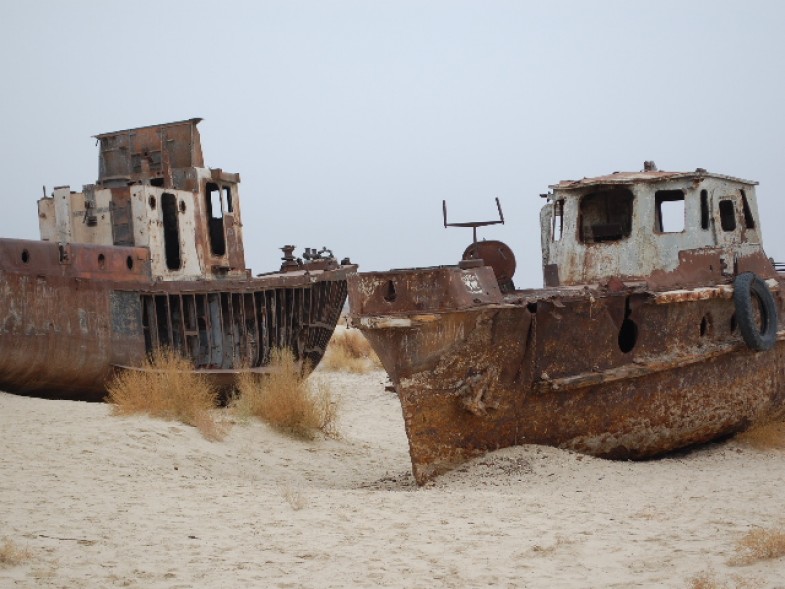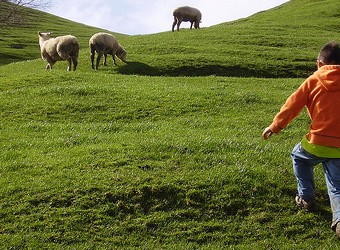I recently joined a delegation of over 60 international organizations from 30 countries to travel to the Aral Sea, along with my colleague from Food &Water Watch International Policy Director Darcey O’Callaghan.
Once the fourth largest freshwater sea in the world, it is now a mere shadow of itself. It has shrunk 13 times by volume, and seven times by land area. Large swathes of what was once the Aral Sea has ceded to what is now known as Aralkum desert — one of the most shocking man-made environmental calamities of the 21st century. To stare at the cemetery of ships that once docked at the edge of the sea — now 60 miles away from what was once the coastline of a robust fishing village, Moynak — is to witness a true tragedy of the commons.
It was unofficial Soviet policy to drain the sea to irrigate Uzbekistan’s fields for cotton production. Today, cotton still drives the Uzbek economy, although the government told the delegation that it is attempting to diversify its agricultural output towards less water-reliant crops.
While in Moynak, we met several residents who told the delegation about skyrocketing health problems due to the dust and salt swirling around the dried up seabed, the economic losses of a once-bustling fishing community, and salinity and chemical toxicity that has made the sea uninhabitable for aquatic life, the surrounding soil unfit for agriculture, and the source drinking water unfit to drink. We met a man who had worked at the Moynak fish cannery for 44 years before it closed in the early 90s. Even now, he says, he comes to the building to open it every day and look around at the empty rooms and remember his past. “This factory is my mother, my wife, my daughter,” he said. “It is my heart.”
This man worked at the Moynak fish cannery for 44 years before it closed in the early 90’s. For him, the cannery was “my mother, my wife, my daughter…my heart.”
The trip to the Aral was the prelude to a conference organized by the Ecological Movement of Uzbekistan to discuss transboundary water management—a sensitive topic in a region beset by conflicts over energy and water. Upstream countries Tajikistan and Kyrgyzstan, rich in water resources that melt of from the glaciers of the Pamir Mountains, want to use the water for energy. Downstream countries—Uzbekistan, Kazakhstan, and Turkmenistan—also need the water for agriculture. When these countries were part of the Soviet Union, upstream water was traded for downstream energy in the form of gas and coal. Now that these are independent states, the trade-off can become tense.
That’s where the commons come in. In her talk at the conference, Darcey O’Callaghan discussed the need to manage our freshwater resources as a common resource, owned by all and managed in the public interest of those who share it. It’s an important concept today as the international development community is increasingly shifting away from the centuries-old commons management approach to water to one that puts a market price on this resource that no one can live without. This market-based approach to water management “has left a legacy of corruption, sky-high water rates, cut-offs of water to millions of people, reduced water quality, nepotism, pollution, worker lay-offs and broken promises,” according to Food & Water Watch Board Chair Maude Barlow, who wrote an excellent primer on the concept in Our Water Commons: Toward a New Freshwater Narrative.
Barlow notes three major problems with the abandonment of water as a commons and the adoption of water as a commodity. First, there is no profit in conservation. Market forces rely on supply and demand, and low supply tends to make prices go up—a boon to private water interests. Secondly, with no regulatory oversight or government control, there will be no protections for the natural world; unregulated water transfers in the hands of private brokers leave few protections in place to keep watersheds and ecosystems healthy so that life can thrive. Lastly, water will naturally flow where the money is if it is a commodity—not where it’s most needed to serve basic needs.
Barlow argues for a counter-narrative to individual ownership and control of essential resources and a legal framework for commons management. While the reasons for the Aral Sea’s demise are complex, the solution may lie in returning to a commons management framework. It needs to be jointly managed in ways that support the surrounding ecosystem and prioritize people’s basic needs, not the needs of one sector over the other (industrial agriculture in downstream countries, energy in upstream countries.) Communities should have a say in how their water is used.
And in America as elsewhere around the world, the Aral Sea crisis should serve as a cautionary tale and a rallying cry for protecting our freshwater resources in the public interest, through a commons-based, not market-based, approach.
This story first appeared on the website of Food & Water Watch, an organization that uses the principles of the commons to protect our food and water supply.








